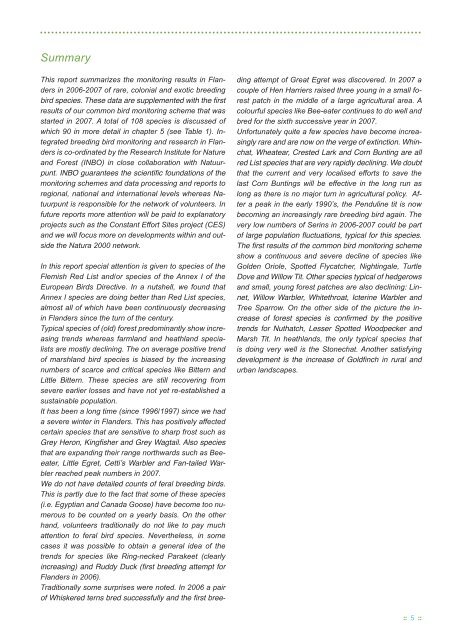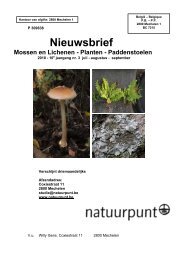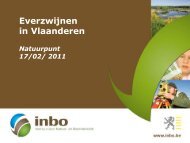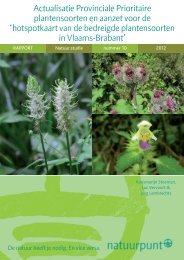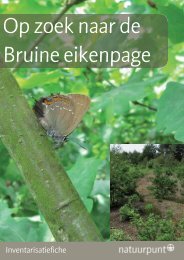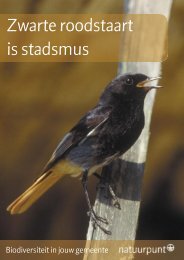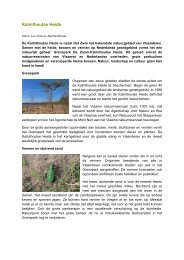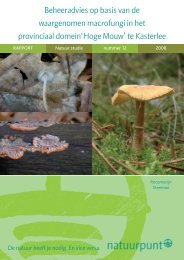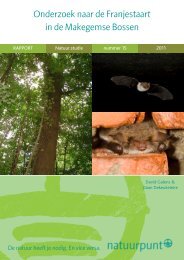Broedvogels in Vlaanderen 2006-2007 - Instituut voor Natuur- en ...
Broedvogels in Vlaanderen 2006-2007 - Instituut voor Natuur- en ...
Broedvogels in Vlaanderen 2006-2007 - Instituut voor Natuur- en ...
Create successful ePaper yourself
Turn your PDF publications into a flip-book with our unique Google optimized e-Paper software.
Summary<br />
This report summarizes the monitor<strong>in</strong>g results <strong>in</strong> Flanders<br />
<strong>in</strong> <strong>2006</strong>-<strong>2007</strong> of rare, colonial and exotic breed<strong>in</strong>g<br />
bird species. These data are supplem<strong>en</strong>ted with the first<br />
results of our common bird monitor<strong>in</strong>g scheme that was<br />
started <strong>in</strong> <strong>2007</strong>. A total of 108 species is discussed of<br />
which 90 <strong>in</strong> more detail <strong>in</strong> chapter 5 (see Table 1). Integrated<br />
breed<strong>in</strong>g bird monitor<strong>in</strong>g and research <strong>in</strong> Flanders<br />
is co-ord<strong>in</strong>ated by the Research Institute for Nature<br />
and Forest (INBO) <strong>in</strong> close collaboration with <strong>Natuur</strong>punt.<br />
INBO guarantees the sci<strong>en</strong>tific foundations of the<br />
monitor<strong>in</strong>g schemes and data process<strong>in</strong>g and reports to<br />
regional, national and <strong>in</strong>ternational levels whereas <strong>Natuur</strong>punt<br />
is responsible for the network of volunteers. In<br />
future reports more att<strong>en</strong>tion will be paid to explanatory<br />
projects such as the Constant Effort Sites project (CES)<br />
and we will focus more on developm<strong>en</strong>ts with<strong>in</strong> and outside<br />
the Natura 2000 network.<br />
In this report special att<strong>en</strong>tion is giv<strong>en</strong> to species of the<br />
Flemish Red List and/or species of the Annex I of the<br />
European Birds Directive. In a nutshell, we found that<br />
Annex I species are do<strong>in</strong>g better than Red List species,<br />
almost all of which have be<strong>en</strong> cont<strong>in</strong>uously decreas<strong>in</strong>g<br />
<strong>in</strong> Flanders s<strong>in</strong>ce the turn of the c<strong>en</strong>tury.<br />
Typical species of (old) forest predom<strong>in</strong>antly show <strong>in</strong>creas<strong>in</strong>g<br />
tr<strong>en</strong>ds whereas farmland and heathland specialists<br />
are mostly decl<strong>in</strong><strong>in</strong>g. The on average positive tr<strong>en</strong>d<br />
of marshland bird species is biased by the <strong>in</strong>creas<strong>in</strong>g<br />
numbers of scarce and critical species like Bittern and<br />
Little Bittern. These species are still recover<strong>in</strong>g from<br />
severe earlier losses and have not yet re-established a<br />
susta<strong>in</strong>able population.<br />
It has be<strong>en</strong> a long time (s<strong>in</strong>ce 1996/1997) s<strong>in</strong>ce we had<br />
a severe w<strong>in</strong>ter <strong>in</strong> Flanders. This has positively affected<br />
certa<strong>in</strong> species that are s<strong>en</strong>sitive to sharp frost such as<br />
Grey Heron, K<strong>in</strong>gfisher and Grey Wagtail. Also species<br />
that are expand<strong>in</strong>g their range northwards such as Beeeater,<br />
Little Egret, Cetti’s Warbler and Fan-tailed Warbler<br />
reached peak numbers <strong>in</strong> <strong>2007</strong>.<br />
We do not have detailed counts of feral breed<strong>in</strong>g birds.<br />
This is partly due to the fact that some of these species<br />
(i.e. Egyptian and Canada Goose) have become too numerous<br />
to be counted on a yearly basis. On the other<br />
hand, volunteers traditionally do not like to pay much<br />
att<strong>en</strong>tion to feral bird species. Nevertheless, <strong>in</strong> some<br />
cases it was possible to obta<strong>in</strong> a g<strong>en</strong>eral idea of the<br />
tr<strong>en</strong>ds for species like R<strong>in</strong>g-necked Parakeet (clearly<br />
<strong>in</strong>creas<strong>in</strong>g) and Ruddy Duck (first breed<strong>in</strong>g attempt for<br />
Flanders <strong>in</strong> <strong>2006</strong>).<br />
Traditionally some surprises were noted. In <strong>2006</strong> a pair<br />
of Whiskered terns bred successfully and the first breed<strong>in</strong>g<br />
attempt of Great Egret was discovered. In <strong>2007</strong> a<br />
couple of H<strong>en</strong> Harriers raised three young <strong>in</strong> a small forest<br />
patch <strong>in</strong> the middle of a large agricultural area. A<br />
colourful species like Bee-eater cont<strong>in</strong>ues to do well and<br />
bred for the sixth successive year <strong>in</strong> <strong>2007</strong>.<br />
Unfortunately quite a few species have become <strong>in</strong>creas<strong>in</strong>gly<br />
rare and are now on the verge of ext<strong>in</strong>ction. Wh<strong>in</strong>chat,<br />
Wheatear, Crested Lark and Corn Bunt<strong>in</strong>g are all<br />
red List species that are very rapidly decl<strong>in</strong><strong>in</strong>g. We doubt<br />
that the curr<strong>en</strong>t and very localised efforts to save the<br />
last Corn Bunt<strong>in</strong>gs will be effective <strong>in</strong> the long run as<br />
long as there is no major turn <strong>in</strong> agricultural policy. After<br />
a peak <strong>in</strong> the early 1990’s, the P<strong>en</strong>dul<strong>in</strong>e tit is now<br />
becom<strong>in</strong>g an <strong>in</strong>creas<strong>in</strong>gly rare breed<strong>in</strong>g bird aga<strong>in</strong>. The<br />
very low numbers of Ser<strong>in</strong>s <strong>in</strong> <strong>2006</strong>-<strong>2007</strong> could be part<br />
of large population fluctuations, typical for this species.<br />
The first results of the common bird monitor<strong>in</strong>g scheme<br />
show a cont<strong>in</strong>uous and severe decl<strong>in</strong>e of species like<br />
Gold<strong>en</strong> Oriole, Spotted Flycatcher, Night<strong>in</strong>gale, Turtle<br />
Dove and Willow Tit. Other species typical of hedgerows<br />
and small, young forest patches are also decl<strong>in</strong><strong>in</strong>g: L<strong>in</strong>net,<br />
Willow Warbler, Whitethroat, Icter<strong>in</strong>e Warbler and<br />
Tree Sparrow. On the other side of the picture the <strong>in</strong>crease<br />
of forest species is confirmed by the positive<br />
tr<strong>en</strong>ds for Nuthatch, Lesser Spotted Woodpecker and<br />
Marsh Tit. In heathlands, the only typical species that<br />
is do<strong>in</strong>g very well is the Stonechat. Another satisfy<strong>in</strong>g<br />
developm<strong>en</strong>t is the <strong>in</strong>crease of Goldf<strong>in</strong>ch <strong>in</strong> rural and<br />
urban landscapes.<br />
:: 5 ::


